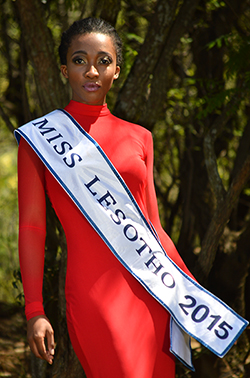 |
| Relebohile Kobeli - the beauty queen of Lesotho |
Relebohile Kobeli was crowned Miss Lesotho 2015 earlier this year, and is now en route to Miss World International 2015 in China to represent the mountainous Kingdom. The beauty pageant, which takes place between November and December, will see contestants from over 150 countries contending for the title.
The nineteen-year-old second-year Geography and Environmental Management student at the University of the Free State (UFS) also won Miss Lesotho in 2014. She holds other titles, such as Miss Outeniqua 2014, and First Princess Face of Lesotho 2013.
What would it mean to be the first from Lesotho to sit on the Miss World throne?
I believe that it would be a turning point for pageantry in Lesotho. We are one of the few countries that do not fully recognise pageants, and the value they add to the tourism industry. Winning the throne would be putting into practice the theory that we, as beauty queens in Lesotho, always practice what we preach.
Since beginning this Miss World contest, in what way have you reached out to your community through the Beauty with a Purpose project?
My Beauty with a Purpose project focuses mainly on introducing and helping start up sustainable projects in communities. I wanted to move away from giving people donations to giving them the skills to ensure their long-term livelihood.
What skill sets do you possess that are essential to succeeding as an international first queen?
I am a very creative individual who thinks on her feet. That is important for me because, when you are far away from home, should things go wrong, there's no room for panic. I am sociable and human-centered, I relate to different people, regardless of cultural differences, and, as an international queen, it is important to be appreciative of others’ way of life, regardless of how different it is are from your own.
Rolene Strauss, the current Miss World, stated her ambition to capitalise on promoting forgiveness, hope, and unity during her tenure. What are you hoping to achieve, given the chance as her successor?
I would definitely speak about self-reliance among young women and the youth at large. I come from a country where not everyone is lucky enough to get a job. In such cases, young men and women fall into crime, young women become victims of sexual abuse or prostitution, and, although one may argue that that is self-reliance, is it sustainable? Is it not escaping one fire to jump into another? It is important for me to represent every girl who has ever had a dream. I am spreading the message of possibilities when the world is yelling "Impossible!"
What has been the highlight of your term as Miss Lesotho?
My greatest highlight was finding myself through service to others. I discovered that the more I invest in myself, the more of me I can give and share.
The Miss Lesotho 2016 competition is around the corner, what words of wisdom would you like to share with hopefuls?
Pageantry is not all about pretty dresses and tiaras. It is hard work. Always be humble, and remember that, whatever the outcome, it is your life's journey. You are destined for greatness. Don't deny yourself that privilege.
In your experience, what is the Kovsie feeling referred to in the maxim “Only a Kovsie knows the feeling”?
It is the desire to want to be great, the motivation to live to my full potential.